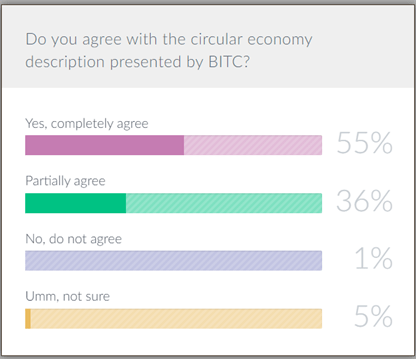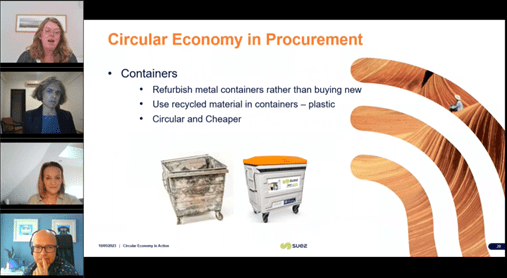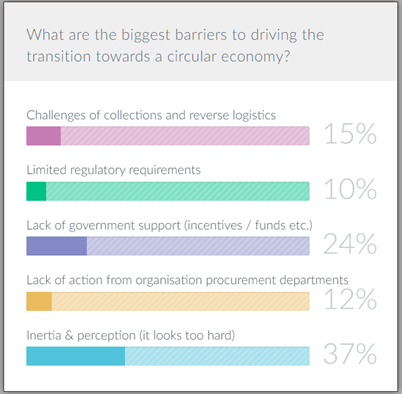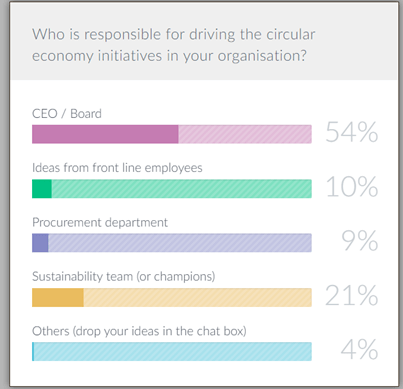Webinar highlights: Reviewing the circular economy in action
12th May 2023
Following our recent webinar on ‘Reviewing the circular economy in action’, Bethany Ciftci, Internal Communications Executive at SUEZ recycling and recovery UK, shares her thoughts and takeaways from the session.
In our latest webinar, chaired by Dr Adam Read, our panel of industry experts talked about their journeys to going ‘more circular’ and discussed the very real barriers to innovation and disruption that are holding organisations back. Maya De Souza from Business in the Community (BITC), Ann Beavis from Crown Workspace and our own Wendy Storey from SUEZ shared their thoughts on how we can build momentum and get more people on board with making circularity happen in the workplace.
Using a common language
When it comes to defining the circular economy, it’s important that we’re using a common language. As part of the work they are doing to help businesses create more circular business models, BITC have created their own definition of the circular economy:
“Products, services, and infrastructure are designed, produced, used, and managed at end of life, to maximise value and minimise waste, reducing demand for precious primary resources, lowering carbon emissions, reducing impacts on nature, and allowing the regeneration of natural systems.”
 When asked whether the audience agreed with this definition, 55% were in complete agreement, whilst 36% partially agreed. That 36% is interesting to me, and personally it’s the option that I selected as a viewer. Although this is a great definition, in my opinion, the circular economy model is about eradicating waste, not simply minimising it. However, a common theme throughout the webinar was the need for taking small steps when it comes to putting the circular economy into action rather than waiting for the opportunity for a seismic shift. And when it comes to barriers to change, which I reflect on later, feeling overwhelmed and comments like ‘it just looks too hard’ were also a recurring theme. So, this may be BITC’s way of setting a more attainable definition that is less likely to put people off from the get-go, whether they be frontline colleagues or the CEO.
When asked whether the audience agreed with this definition, 55% were in complete agreement, whilst 36% partially agreed. That 36% is interesting to me, and personally it’s the option that I selected as a viewer. Although this is a great definition, in my opinion, the circular economy model is about eradicating waste, not simply minimising it. However, a common theme throughout the webinar was the need for taking small steps when it comes to putting the circular economy into action rather than waiting for the opportunity for a seismic shift. And when it comes to barriers to change, which I reflect on later, feeling overwhelmed and comments like ‘it just looks too hard’ were also a recurring theme. So, this may be BITC’s way of setting a more attainable definition that is less likely to put people off from the get-go, whether they be frontline colleagues or the CEO.
The circular economy in action
So, when it comes down to it, what does it look like to be putting the circular economy into practice within an organisation? Ann gave some great examples from Crown Workspace during her presentation. Crown is a commercial relocation company, specialising in moving and changing large organisations. Fifteen years ago, having a circular business strategy was unheard of for them. However, their core proposition now involves keeping existing furniture in use and refurbishing or upcycling it to meet new needs of their customers.

Wendy also discussed the ways that SUEZ are making the circular economy part of our daily business, specifically within procurement. Her role is to improve knowledge, skills, and processes around sustainable procurement internally and to collaborate with suppliers who have shared values. She talked about refurbishing metal waste containers rather than buying them new. Last year, SUEZ refurbished 3,000 containers which saved around £500,000 and reduced carbon emissions by 1.2 tonnes. Another example Wendy gave was moving to chemical-free cleaning products which are in bigger containers and can be diluted on site. This results in using less plastic and reducing transport, and it also creates a social benefit for the cleaners using less chemicals whilst working.

Barriers to change?
The above examples seem great, after all they’re better for the planet, people (colleagues and customers), and ultimately profit. So, why aren’t all companies putting the circular economy into action?
Maya mentioned a lack of knowledge, investment (upfront costs and human capital), the extent of change needed (a shift in business models and consumer behaviour), and the level of collaboration required as some of the biggest barriers to change. This was echoed by Ann, with a few additional comments around reputational risk, lack of relevant metrics, and lack of vision around the opportunity. Wendy had similar views, adding lack of innovation and lack of infrastructure into the mix.
 Then it was the audience’s turn to share their thoughts in a poll. When asked what they think the biggest barrier to driving the transition towards a circular economy is, 37% voted for inertia (it’s hard to change) and perception (of the issue) whilst 24% voted for a lack of government support in terms of investment or clearer policies. Maya mentioned that we can’t expect the government to do everything for us, and that businesses need to start making progress themselves. Ann felt it’s time for industry bodies to take a bit more responsibility as we’re all facing the same challenges, stating “it shouldn’t be a competitive space but a collaborative space”. I tend to agree and it was great to hear that SUEZ are working within the sector and through our supply chains to ensure we are making the right choices when it comes to what we buy and how we manage them.
Then it was the audience’s turn to share their thoughts in a poll. When asked what they think the biggest barrier to driving the transition towards a circular economy is, 37% voted for inertia (it’s hard to change) and perception (of the issue) whilst 24% voted for a lack of government support in terms of investment or clearer policies. Maya mentioned that we can’t expect the government to do everything for us, and that businesses need to start making progress themselves. Ann felt it’s time for industry bodies to take a bit more responsibility as we’re all facing the same challenges, stating “it shouldn’t be a competitive space but a collaborative space”. I tend to agree and it was great to hear that SUEZ are working within the sector and through our supply chains to ensure we are making the right choices when it comes to what we buy and how we manage them.
Who’s driving circularity then?
Another theme during the webinar was who’s responsible (or should be) for driving change towards greater circularity within an organisation. Wendy mentioned that you need both top-down and bottom-up encouragement; leaders need to approve initiatives but it’s the colleagues out on sites who will actually make change happen. Ann agreed in that it should be both, however she mentioned that enthusiastic people with good intentions might not always have the knowledge and skills needed to get things right. So, it’s investing in training, providing guidance, and embedding circularity into employees’ targets that is really key.
 The question was then put to the audience and 54% voted for the CEO and board members as the biggest influence on making circular business principles a reality. All the panellists agreed that this is the case, rightly or wrongly, because without your CEO and board’s support, you’ll be fighting an uphill battle. At SUEZ, we have a highly motivated UK Senior Management Team who are passionate about the triple bottom line and are embedding circular economy principles within our nine strategic goals for the business, recognising that a sustainable business is what we are and what we must be. Interestingly, 21% voted for sustainability teams/champions, which was a great point because these groups will always play a critical role in nudging and encouraging leaders to change and improve, by giving examples and showing positive progress at sites or within specific business units that can be used as templates for other campaigns and programmes.
The question was then put to the audience and 54% voted for the CEO and board members as the biggest influence on making circular business principles a reality. All the panellists agreed that this is the case, rightly or wrongly, because without your CEO and board’s support, you’ll be fighting an uphill battle. At SUEZ, we have a highly motivated UK Senior Management Team who are passionate about the triple bottom line and are embedding circular economy principles within our nine strategic goals for the business, recognising that a sustainable business is what we are and what we must be. Interestingly, 21% voted for sustainability teams/champions, which was a great point because these groups will always play a critical role in nudging and encouraging leaders to change and improve, by giving examples and showing positive progress at sites or within specific business units that can be used as templates for other campaigns and programmes.
The bottom line – make it happen
In conclusion, it’s clear that the journey to going circular isn’t easy for a lot of organisations, but it is doable, and real progress is being made. There are a lot of barriers to overcome, however the key is finding passionate people to get started with small steps that will build momentum and free up space for creativity and innovation in your organisation. Everyone has a part to play, from the top-down to the bottom-up, so rather than waiting around for something to change, why not go ahead and try to do one new thing today, no matter how small, that gets you on the right track?
Watch the full webinar recording on Reviewing the circular economy in action.
Tweet